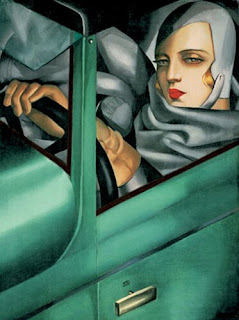«Arnold Schoenberg remains one of the most controversial figures in the history of music. From the final years of the nineteenth century to the period following the World War II, Schoenberg produced music of great stylistic diversity, inspiring fanatical devotion from students, admiration from peers like Mahler, Strauss, and Busoni, riotous anger from conservative Viennese audiences, and unmitigated hatred from his many detractors.» (
in http://www.allmusic.com/artist/arnold-schoenberg-mn0000691043)
There is no better way to introduce this 20th century austrian composer to the general public. Schoenberg´s ideas were misunderstood by critics in the Twenties and even today we miss the point of his achievement. Fear not because I will do my best not to enter into details concerning music theory. So...baby steps then.
Schoenberg (Schönberg in german) invented the twelve tone composition or, as it is commonly known, the dodecaphonic serial method or just serialism. Basically, you have 12 notes of a chromatic scale organized equally and independently.They are arranged in what is called a row, or series, chosen by the composer. Each note can be repeated whenever you want, as long as you bear in mind that, when you change the note, you are also changing the row. Therefore, you cannot use the notes you used before until you play all the twelve notes of the current row you decided to use. The composer is also entitled to do some transformations:
prime ( the initial row), i
nversion (transpose the row to begin in another note but with the same intervals),
retrograde (play the row backwards) and
retrograde-inversion ( a combination of the former two). Schoenberg also used several mathematical formulas to manipulate the series, breaking it into several parts and work them separately. By this time, we are all screaming "That is just...atonal!". And Schoenberg was indeed accused of making atonal pieces. In 1908, when
String Quartet #2, op.10 with a soprano was performed for the first time, the audience was throwned into confusion. They declared the composer "insane" and the title of "inventor of atonalism" was bestowed upon him by reporters.
String Quartet #2 op.10 (1908) Mov.3-
http://www.youtube.com/watch?v=eQWofSHdFcQ;
Schoenberg´s goal wasn´t to cut ties with the 19th century composers nor with the traditional classical forms. He was a Wagner, Brahms and a Strauss fan and their influence is evident in some of his pieces. What the austrian composer wanted was to stretch the boundaries of harmony and composition and to leave his mark on this world because, and I am quoting him, «
I believe what I do and do only what I believe; and woe to anybody who lays
hands on my faith. Such a man I regard as an enemy, and no quarter given!»
Take Mozart and Wagner into consideration. When you listen to a piece of music from the first composer, your ears can pick a familiar melody no matter the change of
tempos. For example, his
Piano Sonata N.11 in A major. The name might not ring any bells but listen to the first ten seconds and I am certain you will recognize it instantly.
Piano Sonata N.11 in A major. Andante grazioso- http://www.youtube.com/watch?v=dP9KWQ8hAYk
You know which keys will going to be played next. You realise along the way that it doesn´t matter what modulations or changes of keys might happen - that familiar melody, that
theme, is bound to return.
Now, remember Wagner? Listen to Siegfried´s Funeral March from
Götterdämmerung (The Twilight of the Gods), the last opera in
The Ring (for short) cycle.
Siegfried´s Funeral March -
http://www.youtube.com/watch?v=zCE_aYJNfQo
Harmonic freedom towards its zenith. Don´t you get lost in a whirlwind of emotions and visual images? The keys have no structural boundaries, they change so quickly or so slowly and far more often, I dare to say, than in Mozart´s time. You don´t know what to expect because, as before, you feel overwhelmed (it is Wagner after all...what could we expect?
Die Valküre/Ride of the Valkyries is just the tip of the iceberg!), but that familiar melodie didn´t even make an appearance...can you grasp it? Was there even one?
Schoenberg´s idea was to look beyond tonality but without losing the classical stucture components. He admired Wagner´s genius but thought that composition needed order. The tonic and the dominant don´t get special treatment within Schoenberg´s twelve tone-technique. By arranging the musical lines and notes separately, he gave them independence and power of its own. All together, they make way to a spellbound harmony when the listener least expects it. His works inspired composers such as Gershwin and John Cage. Alongside Stravinsky, Arnold Shoenberg is considered to be one of the greatest influences in 20th century music.
For further reading on - harmony, intervals, transformation, theme, tempo, traditional classical forms, tonic, dominant, row, and other music terms
http://library.thinkquest.org/3343/web-docs/muglossary.html
http://www.naxos.com/education/glossary.asp
More information on Schoenberg:exextrac biography, works and ideas-
http://www.scena.org/columns/lebrecht/010708-NL-
Excerpt from Schoenberg´s "atonal opera" Moses und Aron" (1932) -
http://www.youtube.com/watch?v=hOWjQuB34b0 ; Piano Concert op.42 (1942)
http://www.youtube.com/watch?v=rZlB2tRyvQw
Cheers!
Ana de Fátima















